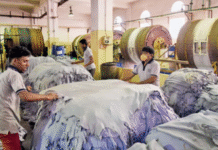It seems the country has been doubling its exports every six years. Not bad, rather, quite encouraging
I was looking at Bangladesh’s export numbers. While the country exported $15.57bn in fiscal 2009, it reached $30.18bn in fiscal 2014. RMG exports during the same period went from $12.35bn to $24.49bn.
Interestingly, our RMG exports to non-traditional markets increased from $850m to $3.6bn. Canada, Italy, Spain, France, the UK, Germany, and the US all became billion-dollar export destinations for Bangladesh during this period.
Our leather and leather goods, jute and jute goods, and also, interestingly, home textiles exports saw an increase to either the billion dollar mark or something close to it, during this timeframe. It seems the country has been doubling its exports every six years. Not bad, rather, quite encouraging. Despite natural disasters, man-made disasters, exchange rate fluctuations, and distressed markets in some of the destination countries, Bangladesh exports have held on.
Credit goes to subsequent governments — they maintained their policy and fiscal supports to the exporting sectors, despite criticism from the media and the citizenry. Duty drawback, bonded warehouses, income tax breaks, subsidies, expansion of export development fund (EDF) parameters, service at the ports, and deferred payment facilities for imports continued. Though equal, or close to equal, facilities didn’t flow into sectors other than RMG, the overall incentive mechanisms, however, were maintained.
Bangladesh needs more exports to accelerate its poverty alleviation success. The BGMEA has set a target of $50bn by the 50th anniversary of the republic. If the “doubling in every six years” record is maintained, we should see leather and leather goods, jute and jute goods, and home textiles to double in exports by 2021 too — closely followed by frozen foods, agriculture exports, IT outsourcing, and more importantly, pharmaceuticals exports.
We can possibly set the target at $60bn for 2021, if not more. Our kids are developing apps for global biggies, two of our pharmaceutical plants will soon be getting US FDA certifications, and more in the offing should make us more confident in our journey forward.
According to reports, our exports meet around 5% of the global $650bn per annum RMG needs. Through continuous investment in people, power, port, production, places, and most importantly, a congenial, or close to congenial, political environment, we could easily grab 8% of the global market shares and boost our RMG exports to $52bn by 2020. But if we don’t, or can’t, make investments in the above mentioned “engines of growth,” we are highly likely to lose out to our competitors India, Vietnam, or even Pakistan.
Christmas sales in American stores from last year have told us our shares, or possible shares, in the store racks is being increasingly gobbled up by India, Vietnam, and Pakistan. USTR data also showed that, while the US’s imports from the world market grew by 2.5%, from Bangladesh, it reduced by 3.6% during the mentioned period, whereas imports from China grew by 4%, India 5.7%, and 14.6% from Vietnam. The July-December 2014 number tells us that, while Bangladesh exports to the rest of the world grew by 2.38%; Vietnam grew its exports by 4.47%, India by 9.96%, and Pakistan by almost 20%.
US buyers or sourcing agencies had to pay $828m in tariff to enter “made in Bangladesh” RMG products to the US in 2013. We need to immediately sit with US decision-makers, including the USTR, to renegotiate a reduced tariff for Bangladesh RMG as well as request for some consideration under the TICFA dialog.
The BGMEA and its president spotted it right: We need to improve productivity to increase and diversify our exports. While Vietnam produces RMG worth $17bn with its 1.3 million workers, Bangladesh produces $24.50bn worth of RMG with 4.4 million workers. Who’s more productive? Vietnam in this case.
Productivity is 77% in Bangladesh, 92% in India, 90% in Vietnam, and 88% in Pakistan. Bangladeshi workers have seen their minimum wage growing from Tk1,662 in 2009 to Tk5,300 in 2014. It is almost close to India now; but look at India’s productivity.
To improve productivity, Bangladesh needs to train it’s workers, install more productive machines in the plants, and ensure a peaceful and productive environment. New machines need triple the investment of older, traditional machines. The entrepreneurs needs low interest rate support from the banks. The competing countries are seeing 5-7% interest rates, whereas a Bangladeshi entrepreneur, at an average, has to pay 10-14% interest rates on a blended basis. Beyond fiscal costs, the factories need to invest money on improving factory environments and also on worker safety. A “shift to quality” is required across all exporting sectors, not just RMG.
Source: Dhaka Tribune










